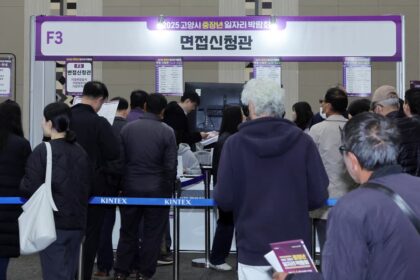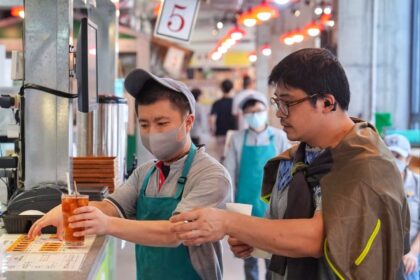New faces behind the counter
Across South Korea, an everyday shift has taken hold in kitchens and dining rooms. A growing share of servers, cashiers, and kitchen assistants are international students, stepping into roles that many young Koreans increasingly pass up. Employers say that even with hourly pay reaching 15,000 won, they struggle to recruit local applicants for entry level restaurant work. Job listings that once drew a steady flow of Korean students now attract classmates from abroad who are balancing lectures with late evenings on the floor or at the dish sink.
- New faces behind the counter
- Why many local youths are opting out
- Visa changes turned students into a ready labor pool
- Why employers favor students over the EPS route
- Compliance pressures and off the books practices
- Campuses and neighborhoods feel the change
- Policy shift opens more service roles to E-9 workers
- Language and service quality in busy dining rooms
- The economics for small restaurants
- What it means for the wider labor market
- What to Know
Government figures reflect the shift. The number of foreign workers in food and hospitality rose from about 107,000 in 2022 to 131,000 in 2024, an increase of 22.4 percent. Student visa holders have also grown sharply. The Ministry of Justice counts 263,000 holders of D-2 and D-4 study visas in 2024, up by more than a third over two years. A major driver is a 2023 rule change that relaxed part time work limits for international students. Undergraduates with intermediate Korean can now work up to 25 hours on weekdays during the semester, with more time allowed on weekends. Businesses, especially small eateries that staff up around lunch and dinner rushes, say this flexibility matches their needs.
Hiring managers point to practical advantages. In a June survey by the job platform Alba Cheonguk, nearly 38 percent of small business owners said they had recently hired or were currently employing foreign students. Respondents praised dependable attendance and a willingness to take irregular shifts. They also flagged hurdles, including communication problems, training time, and the need to track visa rules on working hours. The common thread is that students have become a reliable standby for roles that must be filled quickly when demand rises.
Why many local youths are opting out
The work is steady and honest, yet fewer Korean youths see a reason to take it. Restaurant jobs often require late nights and weekends, last minute schedule changes, and long stretches on one’s feet. Many students prefer internships that align with career plans or exam preparation. Others choose delivery platforms and tutoring because they can set their own hours and avoid late closing shifts. Pay has inched up at many eateries, but schedule stability and the promise of advancement often matter more than a small difference in hourly wages.
Cultural expectations play a part. For students aiming at office roles after graduation, service work is viewed as a short stop, not a bridge to a full career. Owners have raised wages where they can, yet higher food costs and rent leave little room to add benefits or guarantee eight hour shifts. The result is a mismatch: thousands of restaurants need reliable help at peak times, while many young Koreans are looking for predictable schedules and resume building assignments.
Visa changes turned students into a ready labor pool
The Ministry of Justice updated part time work rules for international students in 2023. Those with intermediate Korean proficiency can now work up to 25 hours on weekdays during academic terms, and they can take on extra hours on weekends and during vacations. The policy recognizes that many restaurants, cafes, and convenience stores need short bursts of staffing during lunch, dinner, and late evening. That pattern fits the timetables of students who can stack shifts around classes.
Two visa categories sit at the center of this shift. D-2 visas are typically held by degree seeking students, and D-4 visas are common for language school enrollees and other trainees. Schools help manage eligibility to work, and violation of the limits can put a student’s status at risk. Within those boundaries, employers say student workers are easier to bring on board than other foreign hiring routes. Many can start within days, not months, which is crucial for a small shop facing a sudden staffing gap.
Why employers favor students over the EPS route
South Korea’s Employment Permit System (EPS) for non professional workers on E-9 visas has long been geared toward manufacturing, agriculture, and construction. Bringing in a worker through EPS can involve employer registration, quota windows, candidate matching, health checks, and training. The process helps protect rights and set standards, yet it can take time and paperwork that small eateries find hard to manage. A lunch spot that needs two extra servers this weekend cannot wait through a multistep hiring cycle.
Student hiring, by comparison, is straightforward. Once a manager confirms visa status and permitted hours, shifts can be assigned quickly and adjusted week to week. That immediacy is the core appeal. Owners say they rotate a pool of student workers through lunch rushes or dinner service, adding hours during exam breaks and trimming back during midterms.
Compliance pressures and off the books practices
Not every arrangement is clean. Local reports describe students who work beyond their legal limits, with some paid in cash for extra shifts that do not show up on official payrolls. Several owners acknowledge that a time sheet may list only the legal maximum while additional hours are handled informally. These practices often grow out of pressing needs, like a sudden wave of reservations or an absent coworker, but they place both employer and student at risk.
Immigration authorities can sanction violations with fines, loss of work permission, or in serious cases cancellation of visa status. Employers face penalties for hiring beyond permitted conditions. Small restaurants are not large enough to maintain human resources teams, and language gaps complicate training on rules. Simple tools can help. Clear schedules, clock in apps, and a single record of hours across multiple managers reduce mistakes. Owners also point to the value of appointing one supervisor to check weekly totals for every student worker.
Campuses and neighborhoods feel the change
The rise in student workers has reshaped life around some campuses. At one university in southern Gyeonggi Province, international enrollment has grown tenfold over two years, according to local accounts. Streets nearby have more halal eateries, menus translated into multiple languages, and convenience stores staffed by students between classes. Merchants say a common pattern is to attend the minimum classes needed to maintain status, then head to work in the neighborhood.
Universities juggle several responsibilities at once. They want to attract global talent, support student finances, and keep graduation pathways intact. The rapid shift in enrollment, paired with heavy workloads at local businesses, has stirred a debate over the line between study and work for some students. Schools and local governments have begun to discuss tighter counseling, attendance checks, and better guidance on working limits.
Policy shift opens more service roles to E-9 workers
The government has started to widen options beyond student hiring. The Ministry of Employment and Labor, through its Foreign Workforce Policy Committee, decided in 2025 to expand the Employment Permit System in parts of the service industry. E-9 visa holders are now allowed to serve customers at restaurants and sort parcels at logistics centers. Previously, restaurant owners could bring in E-9 workers mainly as kitchen assistants, and logistics firms could use them to load and unload but not sort. A pilot program that placed foreign cleaners and kitchen assistants at hotels and condominiums is being expanded in stages, with applications managed in several local governments including Seoul and Busan.
Officials say the change answers a reality that small businesses have described for years. Tasks often overlap in a single shift, so keeping E-9 workers out of the dining room disrupted operations. Letting them serve may ease pressure on student workers and give owners a more stable set of options. The government plans to monitor results to balance staffing needs with protecting job opportunities for citizens.
Language and service quality in busy dining rooms
Language ability is now a central job skill. Students with intermediate Korean, as required for expanded work hours, tend to move into customer facing roles faster and earn more shifts. Those still building fluency often start in the kitchen and transition to the floor after training. Many owners are standardizing tasks through checklists, visual guides, and pairing new hires with experienced staff during peak hours. Digital tools help too, from translation apps to kiosk ordering and bilingual menus that reduce the need for complex spoken exchanges.
Customer expectations differ by neighborhood. In tourist districts, shops market multilingual service and welcome mixed language crews. In residential areas, comfort with Korean is still the default. Managers weigh the upfront time to train a new team against the payoffs in smoother service and higher table turnover.
The economics for small restaurants
Margins are tight. Many eateries pay 12,000 to 15,000 won per hour while absorbing higher food costs, rent, and delivery platform fees. Demand can spike after a social media mention and drop the next day. That swings the staffing plan and often prevents owners from guaranteeing long blocks of hours. Young Koreans who need predictable schedules drift toward office internships or exam study, leaving owners to fill the gap with students who can adjust week by week.
Managers who succeed at retention tend to offer predictability in small ways. They post schedules early, rotate weekend duties fairly, provide meals, and share tips transparently. Clear training and respectful communication matter as much as pay. Those habits help keep both local and international staff on board through busy seasons.
What it means for the wider labor market
Foreign residents work across the economy, not just in dining rooms. Data from recent years show that almost half of migrant workers are in mining and manufacturing, with a smaller but growing share in wholesale, retail, and restaurants. The service sector shortage is unlikely to fade quickly. South Korea’s population is aging and birthrates are low, which means fewer young people will be available for shift work later this decade. That reality points to sustained demand for foreign workers across both EPS roles and student positions.
Policy is already adjusting. Wider use of E-9 workers in service roles, clearer work hour rules for students, and better support for language learning all push in the same direction. Stronger guidance and simple compliance tools can protect students from overwork and help owners avoid violations. For diners, the most visible change will remain on the surface: more accents, more languages, and a more international mix keeping tables turning every day.
What to Know
- Foreign workers in food and hospitality rose from about 107,000 in 2022 to 131,000 in 2024, a 22.4 percent increase.
- Student visa holders reached 263,000 in 2024, according to the Ministry of Justice.
- Since 2023, students with intermediate Korean can work up to 25 weekday hours during semesters, with additional time allowed on weekends and vacations.
- A June survey by job platform Alba Cheonguk found nearly 38 percent of small business owners had hired or were employing foreign students.
- Owners cite reliable attendance and flexible hours as strengths, while communication and visa compliance remain challenges.
- Reports persist of students exceeding legal work hours and receiving cash for extra, unreported shifts.
- The government expanded E-9 visa roles in 2025, allowing service at restaurant tables and parcel sorting in logistics centers.
- Language ability is key for customer facing roles, and many shops use training guides and digital tools to support mixed language teams.
- With an aging population and fewer young workers, restaurants are likely to keep relying on a mix of international students and EPS hires.












